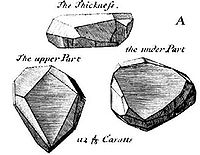
Tavernier Blue
Encyclopedia

Hope Diamond
The Hope Diamond, also known as "Le bleu de France" or "Le Bijou du Roi", is a large, , deep-blue diamond, now housed in the Smithsonian Natural History Museum in Washington, D.C. It is blue to the naked eye because of trace amounts of boron within its crystal structure, but exhibits red...
. This has been accepted by many historians and gemologists for years and was scientifically proven with 3D imaging and prototyping technology in 2005. It is a Type IIb diamond.
Weighing 112 3/16-carats (115.16 modern metric carats, erroneously reported by many others as 110+/- carats), the crudely finished gem was described by the French gem dealer, Jean-Baptiste Tavernier as a "violet", (which was in those days a synonym for blue) and of perfect clarity. The diamond was certainly Indian in origin and likely sourced by Tavernier at the Kollur mine in central India.
Jean-Baptiste Tavernier
Jean-Baptiste Tavernier
Jean-Baptiste Tavernier was a French traveller and pioneer of trade with India, and travels through Persia , most known for works in two quarto volumes, Les Six Voyages de Jean-Baptiste Tavernier and diamond merchant for some important diamonds of the century...
was a French traveler and trader, returning to France from India with many of the largest gems of the era, which he primarily sold to the French royalty and aristocracy.
After being stolen from the French Crown Jewels in 1792 during the turbulence of the French Revolution
French Revolution
The French Revolution , sometimes distinguished as the 'Great French Revolution' , was a period of radical social and political upheaval in France and Europe. The absolute monarchy that had ruled France for centuries collapsed in three years...
, the French Blue was cut into the Hope Diamond in an attempt to prevent its proper identification.
Another blue diamond believed to have been taken from the Tavernier was originally set as a ring for Empress Maria Feodorovna, wife of Emperor Paul I
Paul I of Russia
Paul I was the Emperor of Russia between 1796 and 1801. He also was the 72nd Prince and Grand Master of the Order of Malta .-Childhood:...
. It was given to the State Diamond Fund
Diamond Fund
Diamond Fund is a unique collection of gems, jewelry and natural nuggets, stored and exhibited in Moscow Kremlin, Russia. The Fund dates back to the Russian Crown treasury instituted by emperor Peter I of Russia in 1719.-Imperial treasury:...
in 1860, by her daughter-in-law, the Empress Alexandra Feodorovna. Later, it was mounted into a stick pin. It is preserved in the collection of the Alexander Palace
Alexander Palace
The Alexander Palace is a former imperial residence at Tsarskoye Selo, on a plateau around 30 minutes by train from St Petersburg. It is known as the favourite residence of the last Russian Emperor, Nicholas II, and his family and their initial place of imprisonment after the revolution that...
in Tsarskoye Selo
Tsarskoye Selo
Tsarskoye Selo is the town containing a former Russian residence of the imperial family and visiting nobility, located south from the center of St. Petersburg. It is now part of the town of Pushkin and of the World Heritage Site Saint Petersburg and Related Groups of Monuments.-History:In...
, not far from St Petersburg.

